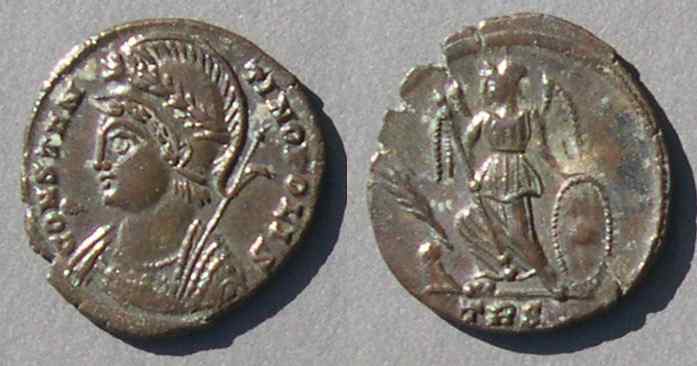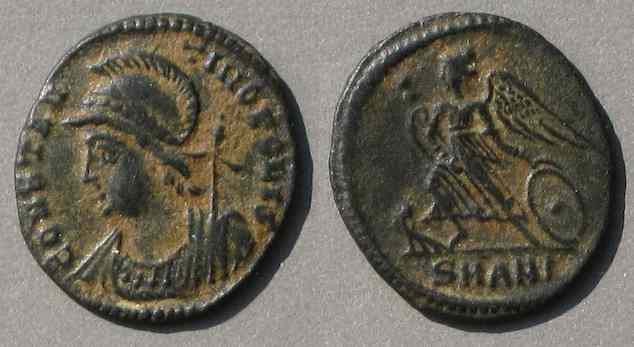CONSTANTINOPOLIS, a very common Roman coin type.
Under the Roman emperor Constantine the Great, who ruled 307-337 AD, the foundation of Constantinople ("Constantine's city") is celebrated on a very common ancient-coin type which was struck from 330-337 AD.
 18 mm.
18 mm.
The obverse depicts the helmeted bust of the city personified,
identified with legend "CONSTANTINOPOLIS".
The helmet is laureate and the figure holds a scepter (a symbol of power).
The reverse shows winged Victory left with her right foot on a tiny ship's prow, holding a scepter and with her left hand resting on a shield. On this piece, the mintmark TRS refers to the mint city of Trier and its second officina (workshop S = secunda = second). The palm branch in the left field is also a symbol of victory.
Reference: RIC Trier 563. Struck AD 333-34.
Prior to 324 Constantine had ruled in the west and Licinius in the east. When Constantine defeated Licinius with a major naval (thus the prow) victory in 324, he became the sole Augustus. Because of its superb location, he chose the city of Byzantium as the site of his new capital. It is now known as Istanbul in Turkey. The existing city was greatly expanded with a massive building program including new walls and was formally dedicated in 330. The coin type was struck at all mints from 330 until the death of Constantine in 337.
On coins from western mints, as on the coin above, the prow is bold but usually small and lacking some of the distinguishing features of a ship's prow. The next example is from Constantinople and has a prow with details.

20 mm.
The terminal "S" is omitted from the obverse legend.
The reverse prow shows quite a bit of the ship, with a clear ram and oars.
The mintmark is CONSZ • , for Constantinople, officina Z = 7.
Reference: RIC Constantinople 86. Struck 333-335.
Rare medallions with complete galleys confirm the reference to a victory at sea. It is interesting that the commanding admiral was the eldest son of Constantine, the Caesar Crispus, who was executed by Constantine in 326 before this type was issued. The honor of the victory was credited to the Augustus, Constantine himself. The type could hardly be intended to evoke memories of Crispus. In any case, Constantinople had a superb harbor and Victory had been depicted on prows for centuries.
This coin has another interesting feature. The obverse legend, CONSTANTINOPLOI, is the variant found at the four mints (Constantinople, Cyzicus, Heraclea, Nicomedia) located around the Propontus (Sea of Marmora, near Constantinople). It is missing the terminal "S" found elsewhere. According to John Kent this "reflects the fall of the terminal -s in the spoken language and provides an interesting hint as to how instructions reached the engravers." I presume he means that he thinks those four mints received instructions from the same source, there was a oral stage in the transmission, and it was a regionally accepted pronunciation. The missing "S" sound reminds me of modern French pronunciation.
 18 mm.
18 mm.
This example, from Alexandria, shows some of the original thin silver coating. Most examples, even high-grade examples, show no signs of the original surface silvering.
At Alexandria the wings of Victory tend to be more prominent.
Notice, for contrast, how small they are on the first example, from Trier.
Mintmark: SMALA
Reference: RIC Alexandria 64. Struck 333-335.
Even very common coins are interesting. The fact they were common proves they were important--and therefore historically significant--in a way that rarities are not. When Michael Grant was president of the Royal Numismatic Society he devoted a presidential lecture to "Very Common Coins" and their relevance for understanding propaganda and the pattern of Roman coinage. The foundation of Constantinople had an immense influence on the ancient and medieval world. There are few types more historical than CONSTANTINOPOLIS. Imagine what such an important type would be worth if it were combined with great rarity! Rejoice that, instead, it is one of the most common ancient coins of all.
References:
RIC VII, Rome 301, is an AE32-33 medallion with the legend VICTORIA AVG and the emperor in a galley right with 5 rowers, Victory holding wreath and palm, and three standards behind the emperor.
Bruun, RIC VII, page 32, also notes the spelling variant indicates something about regional organization of the mints. He, however, suggests it just represents a "scribal error." If so, no one corrected the mistake for years, which seems unlikely.
Grant, Michael. Numismatic Chronicle, 1955, pp.iii-xii.
Kent, John. "Urbs Roma and Constantinopolis medallions at the mint of Rome" in Scripta Nummaria Romana: Essays Presented to Humphrey Sutherland, 1978 pp.105-113 and plates 12-13.
This page is a slightly revised version of an article originally published in The Celator, November, 1996, pages 26-27.
Additonal photos:

Antioch mint
RIC Antioch 92 or 114
17-15 mm. 1.44 grams. 11:30
Struck 335-337.
This piece has some of the typical Antioch mint "black and tan" (="desert") patina
Return to the main page.
 18 mm.
18 mm.
 18 mm.
18 mm.